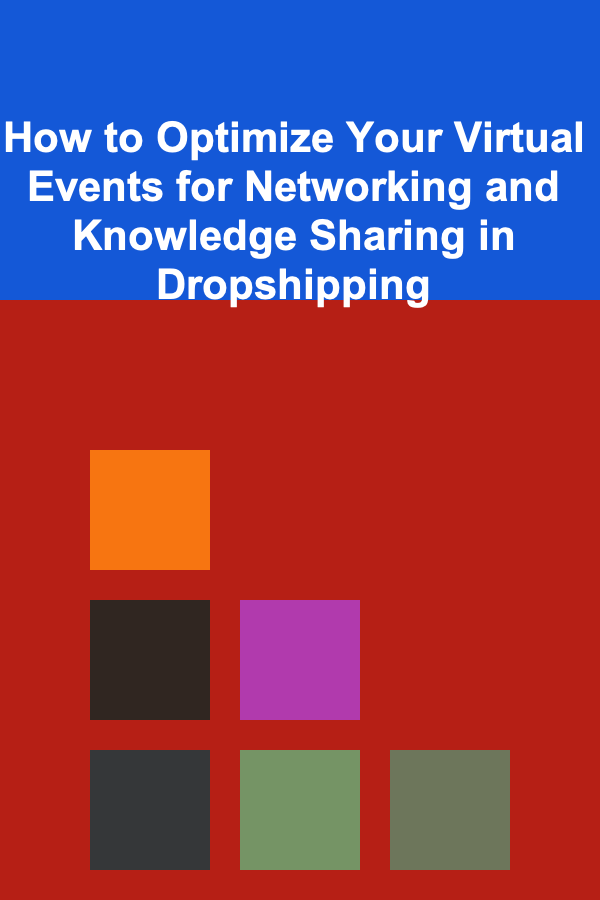
How to Optimize Your Virtual Events for Networking and Knowledge Sharing in Dropshipping
ebook include PDF & Audio bundle (Micro Guide)
$12.99$6.99
Limited Time Offer! Order within the next:

In the fast-paced world of dropshipping, staying ahead of trends, forging valuable partnerships, and continuously learning about new tools and strategies are essential to success. One effective way to do this is by hosting or participating in virtual events. Virtual events offer the flexibility of reaching a global audience, cutting down on logistical costs, and providing access to valuable networking opportunities. However, simply organizing an event is not enough --- it's important to optimize your virtual events for both networking and knowledge sharing.
In this guide, we'll explore how to maximize the impact of your virtual events for dropshipping, ensuring that they provide real value to attendees and help drive your business forward.
Set Clear Objectives for Your Virtual Event
Before diving into event specifics, it's crucial to define your objectives. Knowing what you want to achieve will guide your strategy and help you measure success. In the context of dropshipping, your objectives might include:
- Networking and partnerships: Connecting with potential suppliers, influencers, or fellow entrepreneurs to build collaborations.
- Knowledge sharing: Providing value to your audience by sharing the latest trends, tools, and strategies in dropshipping.
- Customer engagement: Engaging with your current customer base and deepening relationships to encourage loyalty.
- Brand awareness: Promoting your dropshipping business or service to a wider audience.
Once you've outlined your goals, use them as a framework for planning the content, format, and technology you'll need for your event.
Choose the Right Platform and Tools
Selecting the appropriate platform is essential for a smooth virtual event. The platform should facilitate networking, content sharing, and easy communication. Here are a few things to consider when choosing your platform:
2.1. Interactive Features for Networking
For a networking-focused virtual event, you need features that allow participants to engage with each other. Look for platforms that include:
- Breakout rooms: These allow participants to split into smaller groups for focused discussions or one-on-one conversations, mimicking the experience of mingling at an in-person event.
- Virtual lounges or expo halls: These spaces give attendees the opportunity to interact with exhibitors or sponsors, just like at a physical conference.
- Chat functions: Instant messaging or group chats for participants to ask questions or make connections in real-time.
- Live Q&A: This feature lets the audience engage with speakers directly during or after presentations, providing a valuable knowledge-sharing opportunity.
2.2. Seamless Content Delivery
For knowledge sharing, a platform with robust content delivery tools is key. Look for features such as:
- Webinars: The ability to stream presentations to a large audience while still enabling interaction through live chats or polls.
- Screen sharing: This is particularly useful for sharing slides, product demos, or tutorial content.
- On-demand sessions: Offering the option to watch recorded sessions later ensures that attendees who couldn't participate live can still benefit from the content.
- Multimedia integration: Ensure your platform allows the integration of various content types (e.g., videos, slides, documents) to create an engaging and dynamic experience.
Some popular platforms to consider include Zoom, Hopin, and Airmeet, each offering specific features designed to foster networking and knowledge sharing.
Design Content That Offers Value and Encourages Engagement
Content is the backbone of your virtual event, especially when your goal is to share knowledge and build community. It's essential that your content be engaging, relevant, and helpful to your target audience. Here's how you can design content that serves both purposes --- networking and knowledge sharing.
3.1. Focus on Actionable Insights
Your audience is looking for practical takeaways that they can apply immediately to improve their dropshipping businesses. Instead of just offering general advice, aim to provide actionable insights that can have an immediate impact. This could include:
- Case studies: Show real-world examples of dropshipping businesses that have succeeded or failed, and explain why.
- Tools and resources: Share tools, software, or apps that can improve various aspects of dropshipping, from product research to customer service.
- Step-by-step guides: Walk participants through specific strategies, like how to choose profitable products or how to build a high-converting landing page.
3.2. Incorporate Panel Discussions and Q&A Sessions
Panel discussions with experts in the dropshipping industry can provide multiple perspectives on key topics. These sessions encourage a deeper understanding and provide more value than a single speaker. During or after these discussions, allow time for a Q&A session where attendees can ask questions directly. This gives them a chance to clarify doubts, dive deeper into subjects, and engage more meaningfully.
3.3. Encourage Participant Contributions
Foster a sense of community by allowing participants to share their own experiences, tips, and challenges. You can do this by:
- Live polls and surveys: Asking questions during the event to get real-time feedback and spark conversation.
- Networking sessions: Dedicate time for attendees to share their own experiences and challenges, helping them build connections and learn from each other.
- Collaborative brainstorming sessions: Use breakout rooms to allow small groups to brainstorm solutions to common dropshipping problems.
The more you can involve your audience in the content, the more engaged they will be.
Create Meaningful Networking Opportunities
Networking is often one of the primary reasons people attend virtual events. To ensure that your event fosters genuine connections, consider the following:
4.1. Structured Networking Opportunities
Don't leave networking to chance. Plan specific sessions where attendees can meet, such as:
- Speed networking: Like speed dating, but for business! This allows attendees to quickly meet and exchange contact details with several people in a short amount of time.
- Themed networking groups: Organize breakout rooms or virtual spaces for specific interests, such as suppliers, digital marketers, or influencers. This helps people connect with others who share similar business goals.
4.2. Enable Direct Communication
A crucial aspect of successful networking is the ability for attendees to communicate directly. Choose a platform that allows for private messaging, enabling people to follow up after a session or exchange information. You can also facilitate group chats around specific topics where people can continue conversations after the event.
4.3. Post-Event Networking
Don't let the networking end when the event finishes. Provide opportunities for attendees to stay connected through:
- Dedicated networking groups: Consider creating a LinkedIn group or a Slack channel where attendees can continue discussing event topics and forming relationships.
- Follow-up emails: Send personalized follow-up emails that highlight connections made during the event and offer further resources or ways to connect with other attendees.
Post-event networking helps extend the value of the event and nurtures relationships that may turn into future business opportunities.
Foster Continuous Learning Through Recurring Events
One-off events can be valuable, but hosting recurring virtual events creates a long-term knowledge-sharing platform and a community that continues to grow. Consider the following to keep attendees engaged over time:
5.1. Webinars and Workshops
Offer follow-up webinars and workshops that dive deeper into specific dropshipping topics, such as product sourcing, customer retention, or scaling strategies. These smaller, more focused sessions provide attendees with the opportunity to continue learning and engage with experts.
5.2. Ongoing Expert Sessions
Invite industry leaders or dropshipping veterans to offer ongoing expert sessions. These can be live interviews, AMAs (Ask Me Anything), or roundtable discussions that offer continued value to your audience.
5.3. Develop a Knowledge Hub
After the event, make the recorded sessions available through a knowledge hub or resource center on your website. This will create an archive of valuable content that your audience can return to anytime, helping you build a reputation as a thought leader in the dropshipping space.
Measure Success and Gather Feedback
To continuously improve your virtual events, it's essential to measure their success. Gather feedback from attendees after the event through surveys, polls, or informal conversations. Some key metrics to track include:
- Engagement levels: How many people participated in networking sessions? How many questions were asked during presentations?
- Attendee satisfaction: Did participants find the content valuable and relevant?
- Post-event actions: Did attendees take the next step, such as signing up for your services, engaging in a follow-up meeting, or connecting with other participants?
By evaluating these metrics, you can refine your future events, optimize networking opportunities, and enhance the value of the content shared.
Conclusion
Virtual events present a unique opportunity for dropshipping entrepreneurs to network, share knowledge, and build lasting relationships. By carefully selecting the right platform, designing content that provides actionable insights, creating structured networking opportunities, and fostering a community of continuous learning, you can ensure your virtual events drive real value for both your business and your attendees. With thoughtful planning and optimization, your virtual events can become powerful tools in advancing your dropshipping business and forming meaningful connections.

How to Build Custom Shelving for Your Home
Read More
How to Make Money Online as a Beginner with No Skills
Read More
How to Store Your Sports Equipment Efficiently in Limited Space
Read More
How to Support Your Pet During Changes in the Family
Read More
How to Use Deep Learning to Automate and Maximize Your Passive Income
Read More
The Comprehensive Guide to Sound Engineering: Principles, Practice, and Innovation
Read MoreOther Products

How to Build Custom Shelving for Your Home
Read More
How to Make Money Online as a Beginner with No Skills
Read More
How to Store Your Sports Equipment Efficiently in Limited Space
Read More
How to Support Your Pet During Changes in the Family
Read More
How to Use Deep Learning to Automate and Maximize Your Passive Income
Read More